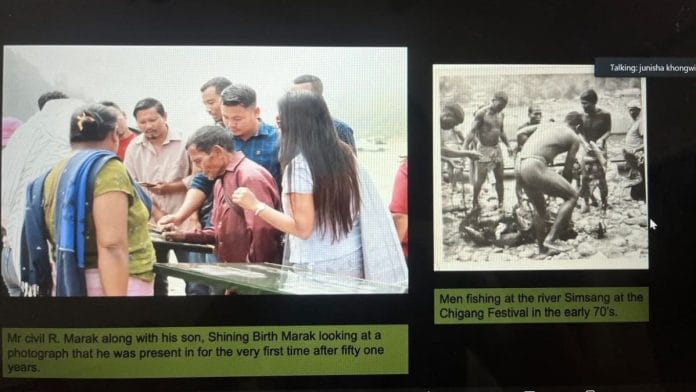New Delhi: In 2019, gunny sacks full of nearly 6,000 photographs landed at the mass media department of St. Anthony’s College in Shillong. Salvaged from a government building slated for demolition, the pictures were initially meant to be dumped in the trash. It took over one-and-a-half years to clean and organise them, and a state-wide moving exhibition to procure more information about them. At the end of this effort, curators were left pleasantly surprised – the photographs turned out to be valuable administrative material documenting 50 years of Meghalaya’s history.
This was one of the anecdotes shared by Junisha Khongwir, a curator at the Northeast India Audio Visual Archive, during an hour-long online session recently organised by the Oral Historical Association of India (OHAI). Since its inception in 2019, the archive has become a significant repository of the state’s oral histories and visual documentation.
Nearly 40 participants tuned in to listen to Khongwir, a professor of mass media at St. Anthony’s College and a photographer. Khongwir recalled that the archive – located within the college premises – started as an attempt to deal with the media department’s existing material.
A humble collection of student graduation projects – comprising video films amassed over 25 years as well as audio productions – evolved into a first-of-its-kind archive dedicated to preserving the northeastern state’s audiovisual heritage.
“The Sasakawa Peace Foundation, Japan, approached us with this pilot idea [of starting a small archive]. And that’s how it started. We basically had a summit where we were calling people and letting them know why archiving is important, especially in this part of the country,” Khongwir said.
The archive has, over the course of five years, collected about 600 films that it is now digitising. It also engages in restoration work, which sometimes includes old wedding videos. The archive simultaneously runs an oral history project where it has collected over 60 interviews by researchers and elderly people.
Also read: Is Delhi really a city of gardens? Mughals, British & CPWD laid them very differently
‘Road to 50’ project
The gunny sacks with grainy photographs came with little to no information. So the archive team decided to put them in the public domain, hoping that people would come forth with the stories behind them. Khongwir displayed these photos near river banks, at parking lots, and any possible location where people could simply walk up to see them.
“That was one way of allowing people to kind of help out with information as well as curating the work in a certain sense. So, that has been one of the practices that really helped us grow as an archive,” she said.
Khongwir saw this as a way of letting people be “part of this whole world” of treasuring legacy. The timing of the roving exhibition coincided with 50 years of Meghalaya’s statehood. While administrative accounts and books were written by leaders of the movement, “historical backgrounds from the other side” were minimal. The archive went in search of unheard stories from volunteers or observers. During this process, the team also learned about the lack of knowledge among school and college students about the 1954 Hill State Movement.
“We went about knocking at many, many, many doors. We asked for stories, we asked for snippets, we asked for photographs, for footages, for newsreels, and we did make a collection, quite a good collection, and we could even build a whole visual timeline (of the movement),” she said. This was the genesis of the ‘Road to 50’ project.
Emotional, personal recollections
One of the exhibition spots for the ‘Road to 50’ project was along a river called Simsang. A visitor at the event identified his father in a black-and-white picture taken in the early 1970s, just after Meghalaya was carved out of Assam. He immediately went to bring his father to the venue. Khongwir shared a picture of the old man seeing the image, where he was proudly holding a net full of fish with some other men.
“It was a very emotional time for him. He told us he vividly remembers that moment because our first chief minister, Captain Sangma was also there. He said that it was such a beautiful moment for them because it was a festival and, these photographers came and took some photographs of them,” she narrated.
The emotional episode highlighted the personal connections that individuals have with their history. Khongwir took the opportunity to underscore the importance of bringing archival materials back to the communities from which they originated.
“I think it’s our duty in some way or the other to kind of, you know, take [the photographs] back to them, show them that this is what it is,” she said.
The archive, Khongwir added, consciously strives to keep the exhibition interactive, friendly and accessible to all. It’s not just meant for an elite, intellectual crowd of scholars and historians, she implied.
“We can keep it in museums but only a certain kind of people enter those spaces. When we actually put our work like this, we learn so much more. We get to share knowledge.”
(Edited by Zoya Bhatti)






